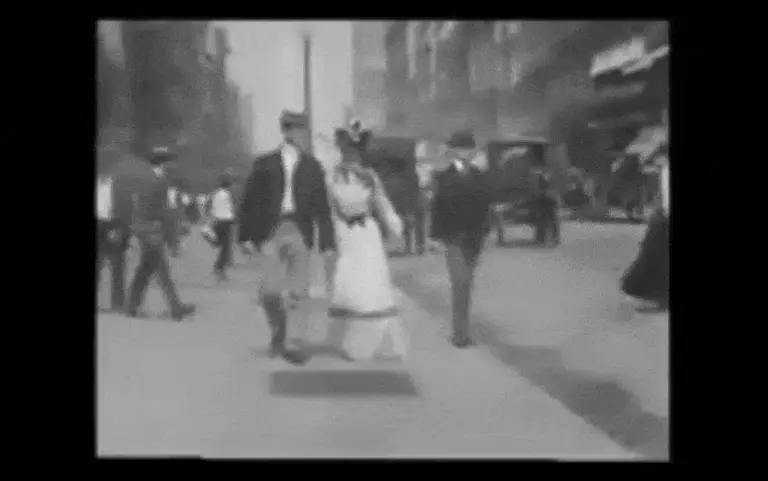Five ‘Tin Pan Alley’ buildings may be landmarked for their musical history

Via LPC
The Landmarks Preservation Commission voted on Tuesday in favor of calendaring five buildings on West 28th Street in Manhattan’s “Tin Pan Alley,” in the neighborhood now called Nomad. The buildings at 47-55 West 28th Street were an integral part of the area known for having New York City’s most significant concentration of sheet music publishers at the turn of the 20th century, and as the birthplace of iconic American songs like “God Bless America.” It’s also where popular music icons like Irving Berlin and George Gershwin wrote songs. Calendaring is the first formal step in the historic status designation process.

The sheet music firms housed in these buildings revolutionized the way the music industry created, promoted and consumed popular music. As more music publishers arrived, the name “Tin Pan Alley” was coined in 1903 to describe the sound of piano music that emanated from every corner of the block.
The name became an all-inclusive term for the music production industry in America in general; it became the inspiration for the music studios of London’s Tin Pan Alley on Denmark Street from 1911-1992.
Built in the 1850s, the Italianate-style row houses got ground floor conversions to accommodate retail storefronts, above which they retain much of their historic detail. Though the music publishers moved away over a century ago, they represent Tin Pan Alley’s significant contributions to American culture.
The first music publisher to move to the block in the heart of what was then an entertainment and red-light district known as the Tenderloin was M. Witmark & Sons, headquartered at 51 West 28th Street from 1893-97 and 49 West 28th Street from 1896-1897. That firm originated the wildly successful practice of gifting “professional copies” of music to well-known singers as a marketing strategy. By 1907 there were 38 publishers on the block.
In addition to hiring “pluggers” to demonstrate their songs in department stores, theaters, vaudeville halls, and other entertainment venues, firms like Witmark engaged in “booming” to inflate the audience’s perception of a song’s popularity. This meant buying dozens of tickets to popular shows, infiltrating the audience and singing the song to be plugged. When people walked out of the theater, they might very well be singing the tune.
Tin Pan Alley is also known for giving unprecedented opportunities to songwriters of color and of Eastern European Jewish descent. The country’s first African-American owned and operated music publishing businesses had offices here.
The Tin Pan Alley era dawned at a unique moment in the development of sound processing technologies and during a notable shift in in-home music culture: The sheet music first produced on Tin Pan Alley was meant to be taken home for live piano performance and entertainment. Between 1901 and 1920, American households began to own record players, and the new recordings were seen as a convenience over the time and expense of piano training.
Sheet music sales peaked at two billion copies in 1910; by then, most of the music publishers in this area had followed the entertainment district to Madison and Times Squares, where big, shiny custom offices were able to accommodate the new in-house orchestras and recording spaces.
Today, the Commission calendared 5 historic buildings on West 28th Street in what became known as “Tin Pan Alley,” home to the most significant concentration of sheet music publishers in NYC at the turn of the 20th century. pic.twitter.com/ePRR0aqfOA
— Landmarks Commission (@nyclandmarks) March 12, 2019
Preservationists have been working to have the block protected under landmark status for years. In October 2017, they rallied for Tin Pan Alley to get landmark status to avoid demolition–especially since the row of buildings had been purchased by developer Yair Levy.
Simeon Bankoff, Executive Director of the Historic Districts Council told 6sqft: “HDC is thrilled that the Landmarks Commission is taking this long-awaited step towards protecting Tin Pan Alley. As the birthplace of American popular music, this block possesses the kind of national significance not often encountered. These buildings are a tangible piece of our country’s heritage, and by preserving them, the LPC will ensure they will continue to be there to educate the generations to come.”
RELATED:
- Extension of NoMad Historic District Has Preservationists at Odds with Building Owners
- Radio Row: A tinkerer’s paradise and makerspace, lost to the World Trade Center
- Tracing the Colorful History of Madison Square Park from the 1800s
- Historic Districts and Landmarking: What They Mean (and How They Could Affect You)



























